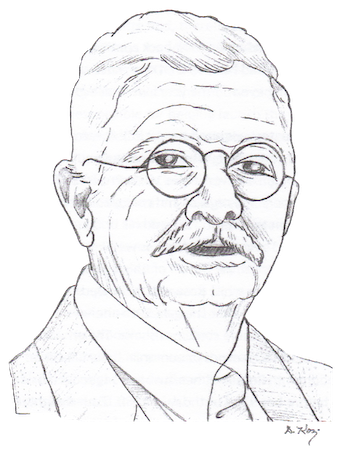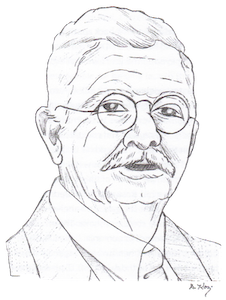Imagined underwater travel as a child while father experimented with flying machines
Lake passed on securing the rights to market the Wright Brother’s plane plans in Europe
“A paper nautilus, that’s all it was at the start.” (Poluhowich 3) Simon Lake’s red hair glistened upon his head, as his imagination animated his pencil sketches. Many boys dream of adventures and sunken treasure; Simon Lake was no ordinary boy, he was extraordinary. He had a vision. Childhood naivety allowed him to dream of a vessel that could function under water. He sketched out these drawings, folded them, and placed them safely in his copy of Jules Verne’s Twenty Thousand Leagues under the Sea. (Poluhowich 3) Years later he will be known as one of the greatest contributors to submarine technology and an innovator who will forever leave his mark on history.
Even though the development of the modern submarine is accredited to John Holland, an Irish-American inventor who rivaled Lake, (Poluhowich 41) it is most improbable that the submarine could have developed to where it is without the contributions of Simon Lake, a simple man who lived here in Milford, Connecticut. Without Lake, who developed submarines mainly as an instrument of peace, the modern submarine would be blind, since it was Lake who developed the predecessor to the periscope. He also developed the twin-hull design, diver’s compartment, even-keel hydroplanes, and many more new technologies.
Simon Lake was born on September 4, 1866 in Pleasantville, New Jersey. (Ditmire website) His creativity thrived in a family that loved to invent things. His father, John Christopher Lake experimented with flying machines. Simon Lake was naturally inspired to invent. Jules Verne’s Twenty Thousand Leagues under the Sea, a novel of undersea travel, was the force that inspired Lake to start developing ways to make that vision a reality (Poluhowich 4).
Initially Lake met with little success in this field due to the need for military submarines, not scavengers, which were Lake’s specialty. Scavengers are submarines designed for undersea searching and salvaging. Lake’s rivalry with Holland drove Lake to improve his designs. Lake as a businessman created and operated over twelve companies on his own. These companies included: “The Argonaut Salvage Company, Lake and Danenhower Inc., Lake Engineering Company, Ltd., The Lake Submarine Company, The Lake Submarine Salvage Corporation, The Lake Torpedo Boat Company, Connecticut Building and Supply Company, Deep Sea Submarine Salvage Corporation, Connecticut Lakolith Corporation, Bedrock Gold Submarine- Machinery Company, The Submarine Exploration and Recovery Company, and The under Water Recovery Corporation.” (Poluhowich 157) These companies made him one of the leading millionaires in Connecticut. Despite this fact, Lake was horrible with money, when asked about his inability to spend money efficiently Lake only said “I’d rather die broke because I had been spending my money doing worthwhile things, than sit around cutting coupons.” (Poluhowich 84)
Lake tried his early designs in Long Island Sound with some initial success. He held about two thousand patents, and in his day, was just as ambitious as his famous rival. (Poluhowich 20) Lake worked quickly and efficiently due to his ability to sketch vehicles before development. Like most inventors, Lake first worked in generalities and did very little with specific details. Even though Lake worked tirelessly on his submarine designs, it was Holland who won the endorsement of the United States Government along with most of its contracts. That very well could be the reason that Simon Lake is not recognized globally for his contributions to the submarine.
During the Russo-Japanese war, Lake went behind the United States government’s back to smuggle parts to Russia so that his submarines could be manufactured. (Ditmire website) That’s not to say that Lake had a bad relationship with the U.S government. Lake met with the President of the United States, Theodore Roosevelt, and with Franklin D. Roosevelt whom President Wilson had appointed Assistant Secretary of the Navy during World War I as well as deep-sea explorer, William Beebe, and Clara Barton, the founder of the Red Cross. (Poluhowich 5) Thus, it is clear; Lake was a very well-connected man; Connections paid off when Lake’s designs were accepted in Europe during World War I, when he developed his “protector” submarine for Russia and Germany. (Poluhowich)
When working on his submarine inventions and ideas, Lake kindly shared a European office he had occupied during World War I with another set of pioneers of exploration and transportation, the Wright brothers. When developing the Argonaut Jr., the submarine that Lake is most famous for, he was finally recognized by the United States, Holland was no longer the only patented submarine visionary developing undersea craft for the government.
Simon Lake first retired in 1915. He was a wealthy man who’s “torpedo boat company was working in full tilt.” (Poluhowich 152) The monotony of retirement was too much for him; therefore, he decided to get back to work. Back at work, in 1920, he experienced economic failure. Yet he maintained a positive outlook. He was quoted saying “I quit this foolishness about retiring, went back to work, lost all of my money, and have been quite happy.” (Poluhowich 152)
Although his predictions that submarines would dominate modern warfare was laughed at and disbelieved by a majority of the officials of the United States Government, he continuously attempted to contribute his ideas reaching out many times to the President Franklin D. Roosevelt about his ideas for transport submarines. (Poluhowich 148) His ideas about a cargo carrying submarine were innovative but still the government rejected the idea, saying that a war machine was needed more than a cargo transport; this did not mean that Lake had stopped working for the government; he was just not fond of tools of war. Some say that had the rivalry between Lake and Holland taken place in a time of peace, Lake may have had more spotlights. Lake was looking to provide the world with the opportunity to explore and salvage the treasures of the sea; whereas Holland was making submarines into weapons for war. Holland was obviously going to be favored, because the United States Government needed weapons more during the war.
Lake’s accomplishments were not totally unnoticed however. Simon Lake died on June 23, 1945. He was seventy-nine years old, when tragedy struck in the form of a heart attack. He left behind three children Thomas Alva Edison Lake his son, his daughters Miriam and Margaret, and his wife Margaret.
Simon Lake’s eulogy explained that, in Simon Lake there existed the qualities of inventor, businessman, and promoter. Together these qualities created a brilliant and dynamic individual. Many of Lake’s inventions were essential to the development of the modern submarine. Today, every submarine on this planet uses the inventions created by Simon Lake. Simon Lake was a classic American inventor. He was a visionary; he accomplished wondrous feats. His ability to dream for the future will motivate generations to come. He will be remembered in history books for his inventions, and an elementary school in Milford is named after him as well. He will forever be known as an innovator, whose submarine helped to shape modern undersea exploration.



